
About UsThe Numismatic Bibliomania Society is a non-profit organization promoting numismatic literature. For more information please see our web site at coinbooks.org SubscriptionsThose wishing to become new E-Sylum subscribers (or wishing to Unsubscribe) can go to the following web page link MembershipThere is a membership application available on the web site Membership Application To join, print the application and return it with your check to the address printed on the application. Membership is only $15 to addresses in the U.S., $20 for First Class mail, and $25 elsewhere. For those without web access, write to: David M. Sundman, Secretary/TreasurerNumismatic Bibliomania
Society AsylumFor Asylum mailing address changes and other membership questions, contact David at this email address: dsundman@LittletonCoin.com SubmissionsTo submit items for publication in The E-Sylum, just Reply to this message, or write to the Editor at this address: whomren@coinlibrary.com
BUY THE BOOK BEFORE THE COINYou won't regret it! |
- WAYNE'S WORDS: THE E-SYLUM JULY 25, 2010
- NEW BOOK: FRIEDBERG'S PAPER MONEY OF UNITED STATES, 19TH EDITION
- NEW BOOK: CONFEDERATE ISSUERS OF TRAIN AND HOER NOTES
- NEW BOOK: 2011 NORTH AMERICAN COINS & PRICES
- ARTICLE PROFILES KRAUSE'S STANDARD CATALOG OF WORLD COINS
- KRAUSE PUBLICATIONS PLANS AUTHOR EVENT AT BOSTON ANA CONVENTION
- AUTHOR FRED REED'S WEB SITE ANNOUNCED
- MORE ON ALAIN DEBELDER'S BELGISCH NOODGELD BOOK
- QUERY: COIN BOOKS WITH AN ENCASED COIN OR MEDAL
- MORE ON HOBBIES MAGAZINE
- MORE ON THE LIBRARY OF COINS AND TREASURY OF COINS ALBUMS
- ROBERT READY AND SONS, ELECTROTYPISTS
- VIETNAMESE BANKNOTE OVERSTAMP TRANSLATION: RUPIA?
- COPYRIGHTS AND REPRINT PERMISSION: WHERE AND FOR HOW LONG?
- DICK JOHNSON: I'M NOT UNFRIENDLY, JUST SLOW TO ADOPT NEW FADS
- RESPONSE TO OPINION ON COIN DESIGN BY COMMITTEE
- GET RID OF COINS ALTOGETHER?
- NOTES FROM E-SYLUM READERS: JULY 25, 2010
- WAYNE'S NUMISMATIC DIARY: JULY 25, 2010
- SHIELD NICKEL RUBBING IN METHODIST SUNDAY SCHOOL BOOKLET
- U.S. TREASURY SEEKS COMMENT ON PAPER MONEY CHANGES FOR THE BLIND
- HONG KONG TO ISSUE NEW BANKNOTES WITH BRAILLE
- BANKNOTE PRINTER DE LA RUE HALTS PRODUCTION OVER PAPER QUALITY
- PENNSYLVANIA ARCHEOLOGISTS FIND VIRGINIA HALFPENNY
- ARCHEOLOGISTS UNEARTH FIRST ANTONIUS PIUS COIN FOUND IN ISRAEL
- BLOGGER BARMAN PROFILED BY THE SATURDAY EVENING POST
- DARING SWEDISH CHOPPER HEIST NETS $5 MILLION
- CIGARETTE VENDING MACHINES CONVERTED TO SELL BOOKS
- FEATURED WEB PAGE: HARRY BASS NUMISMATIC LIBRARY CATALOGS
WAYNE'S WORDS: THE E-SYLUM JULY 25, 2010

Among our new subscribers this week is Musham Damodhar Rao. Welcome aboard! We now have 1,361 subscribers.
This week we open with announcements of three new numismatic books covering U.S. coins and U.S. and Confederate paper money. On the world front we have a short history of Krause Publications' Standard Catalog of World Coins.
Other topics include the search for a book on Belgian notgeld, Hobbies Magazine, and the electrotypes of Robert Ready. To learn about Augustine Shurtleff, the lost art of page layout using paper proofs and wax, Braille banknotes and President Harding's silver dollar, read on. Have a great week, everyone!
Wayne Homren
Numismatic Bibliomania Society
NEW BOOK: FRIEDBERG'S PAPER MONEY OF UNITED STATES, 19TH EDITION
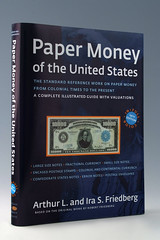 19th Edition of Friedberg's Paper Money of United States:
2010-2011 Edition of Universally Accepted Standard Reference in Full Color for First Time
19th Edition of Friedberg's Paper Money of United States:
2010-2011 Edition of Universally Accepted Standard Reference in Full Color for First Time
Fifty-seven years after its introduction, the nineteenth edition of Paper Money of United States, the standard reference book on United States paper money is being released by The Coin & Currency Institute of Clifton, New Jersey.
In 1953, the late Robert Friedberg (1912-1963) broke new ground when the Treasury Department granted permission for photographs of American paper money to be printed for the first time. The current edition's 328 pages sets the standard once again by featuring notes from America's greatest currency collections, all reproduced in color.
The inaugural edition of Paper Money of the United States also introduced other innovations never before attempted. The subject became standardized and the book earned a permanent place on reference shelves. During the past three decades, it has been completely expanded, revised, and edited by Ira S. Friedberg and Arthur L. Friedberg, who has been recognized by the International Association of Professional Numismatists with its highest honor, the title of Honorary President.
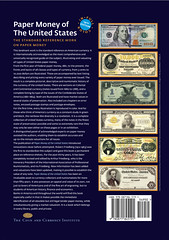 As with any price catalog, the nineteenth edition of Paper Money of the United States is a snapshot in time – and as 2010 begins drawing to a close, the paper money market is witnessing a sustained recovery. As with every edition, all valuations have been adjusted to reflect market conditions, and now for the first time in up to seven states of preservation (Very Good to Gem Uncirculated). There are also several other significant additions to the new volume, making it a necessity for every collector and dealer of American currency.
As with any price catalog, the nineteenth edition of Paper Money of the United States is a snapshot in time – and as 2010 begins drawing to a close, the paper money market is witnessing a sustained recovery. As with every edition, all valuations have been adjusted to reflect market conditions, and now for the first time in up to seven states of preservation (Very Good to Gem Uncirculated). There are also several other significant additions to the new volume, making it a necessity for every collector and dealer of American currency.
There are over twenty new catalog numbers assigned to the Legal Tender Notes of 1862-1863 to more accurately reflect differences among the various issues and their rarity. An increasingly popular area of collecting, “paper money mules” are included for the first time. The term “mule” refers to the plate numbers that appear in small digits on the front and back of every note. Mulings occurred when printing plates got mixed up and were used in a sequence which would appear to be inconsistent. They exist for both large size and small size currency and mules are indicated with a letter “m” and priced accordingly in the book's text.
An entirely new section is devoted to Postage Envelopes, another form of emergency currency along with Fractional Currency and Encased Postage Stamps, created to alleviate the shortage of change needed for commerce during the Civil War. The listing in the Appendix of the 14,348 National Banks that existed from 1863 to 1929 has been redone, as well, now showing the numbers of large size and small size notes known to exist for each note-issuing bank.
From the first year of Federal paper money, 1861, to the present, the fronts and backs of all classes and types of currency, from 3 cents to 10,000 dollars are illustrated. These are accompanied by text listing, describing and pricing every variety of paper money ever issued, more than 10,000 prices in all. With close to 1,000 color photographs, the result is a complete pictorial, descriptive and numismatic history of the currency of the United States.
There are also supplemental sections on Colonial and Continental Currency (notes issued from 1680 to 1788), the Treasury Notes of the War of 1812, considered by some to be the first national currency, a comprehensive listing by type of the issues of the Confederate States of America, and a section devoted to paper money errors.
Paper money collectors depend on the Friedberg Numbering System, a uniform method of cataloging bank notes that is the international standard for American currency. This numbering shorthand, along with the hundreds of photographs, enables anyone to instantly locate a specific banknote, and allows a dealer to advertise a note without need of extensive description. A distinguished panel of acknowledged experts on paper money has assisted the authors, enabling them to establish accurate and up-to-the minute valuations for all issues.
Paper Money of the United States has been an invaluable asset to currency collectors and numismatists for over half a century. It possesses an appeal and value of its own, not just to lovers of Americana and of the fine art of engraving, but to students of American history, finance and economics. It is recognized as a landmark work and is the undisputed standard reference on American currency – internationally acknowledged as the most comprehensive and universally quoted guide on the subject.
Banks in America and throughout the world will find this book especially useful in that it makes possible the immediate identification of all obsolete but still legal tender paper money, while simultaneously giving the collector's value of each note. It is a book which belongs in every library, public and private.
Sample pages from the 19th edition may be seen on the book's website, www.PaperMoneyoftheUS.com .
The book's list price is $49.50 and it is available from book stores, coin and paper money dealers, and from internet book sellers (ISBN 978-087184-519-1). Copies may also be obtained by mail from The Coin & Currency Institute, P.O. Box 1057, Clifton, N.J. 07014. A version of the book on CD-ROM (ISBN 978-087184-909-0) costs $36.50. $5.50 should be added to each order for shipping and handling. Major credit cards are accepted. Call toll-free 1-888-471-1441. Fax (973) 471-1062. E-mail: info@PaperMoneyoftheUS.com. In Europe, contact Spink & Son, Ltd., London.
Most of the book's illustrations are from the Aubrey and Adeline Bebee Collection of United States Paper Money at the American Numismatic Association in Colorado Springs, Colorado. In recognition of this, a specially-bound, serially numbered (1-200) and autographed edition of the book was scheduled to be available at the Annual Convention of American Numismatic Association in Boston, MA from August 10-14 where highlights of the Bebee Collection were to be on display. Proceeds will benefit the A.N.A. Edward C. Rochette Money Museum.
E-Sylum readers may remember that John Nebel took magnificent ultra-high resolution photos of the ANA's Bebee collection. I assumed these were the images used in the book, and wondered if they were properly credited. -Editor
John writes:
I gave a copy of 600dpi Bebee images to Doug Mudd and I hope he passed those on to Arthur, I'd hope they didn't repeat the work done 10 years ago.
The original Bebee note scans are 2540dpi and allow the notes to be printed 50" wide on photographic paper without any loss of sharpness. A couple of those photographic prints are on display in the ANA library.
It was a major project to scan and store the note images with the computer equipment available in 2000, but it was worth it because it is a wonderful collection of beautiful banknotes. Today, one would have to pay $20,000 for a Kodak scanner not quite as good as the one used for the Bebee notes. I be embarrassed to say what the project cost in its entirety.
The notes can be viewed on-line at http://ana-museum.org/. Motivated by a question Scott Rottinghaus asked, programs were developed for the web site which allow clicking on any part of the images to view details in a pop-up window. To make the pop-ups efficient, the banknote images were sliced into about 3.4 million squares, 64 of which are loaded on a mouse click.
To read the earlier E-Sylum article, see: ANA DEBUTS ONLINE BEBEE PAPER MONEY COLLECTION EXHIBIT (www.coinbooks.org/esylum_v12n44a06.html)
NEW BOOK: CONFEDERATE ISSUERS OF TRAIN AND HOER NOTES
 A new book for the collector of Confederate Treasury
notes, Confederate Issuers of Train and Hoer Notes will
revolutionize the perception of the military and civil
endorsements on the backs of Confederate T-39, T-40,
and T-41 interest-bearing $100 notes.
A new book for the collector of Confederate Treasury
notes, Confederate Issuers of Train and Hoer Notes will
revolutionize the perception of the military and civil
endorsements on the backs of Confederate T-39, T-40,
and T-41 interest-bearing $100 notes.
Features:
- 288 pages, most in full color.
- Civil War history is popular, and this book identifies the military Quartermasters and Commissaries of Subsistence who used these interest-bearing notes to purchase supplies for the Confederate war effort. The book also identifies many of the civil agents who disbursed these notes for the Confederate Treasury Department.
- Gathered as a group effort by the members of the Trainmen, this new information is now available to all collectors.
- Rich historical data and anecdotes are provided for many of the endorsers of these notes.
- Full images of the front and back of each note are provided, allowing the collector to quickly identify these signatures.
- The book format is a compact 9” by 6,” and is easily packed into a briefcase for ready reference.
- The appendix is rich in detail, including essays on the classification of these endorsements.
Retail priced at US$60, with a short printing run of 1000 copies, the book is destined to become a collector's item in its own right.
ISBN-13: 978-0-9720386-4-5 ISBN-10: 0-9720386-4-7
For wholesale orders ($510 per case of 20 books, postpaid), contact:
Mike McNeil
CCCA
321 Seventh Street
Mead, CO 80542-4574
mmcneil@k2cable.net
720-308-5740
NEW BOOK: 2011 NORTH AMERICAN COINS & PRICES
 2011 North American Coins & Prices
2011 North American Coins & Prices
by D. Harper, H. Miller, T. Michael
Are you looking for a cool deal this summer?
How about three countries worth of coin data, including photos and current pricing in one book, for under $15? That's what you get, and more, with the new edition of North American Coins & Prices.
This coin book features coins from Canada, Mexico, and the U.S., from the Colonial era to the present, and it's organized alphabetically for easy identification. Its small enough you can take it to shows, yet packed with 45,000 listings, 3,000 actual-size coin illustrations, current values in multiple grades of condition, and expert insight about the coin market.
For more information, or to order, see:
2011 North American Coins & Prices , A Guide to U.S., Canadian and Mexican Coins, 20th Edition
(www.shopnumismaster.com/product/2011-north-american
-coins-and-prices/us-coins/)
ARTICLE PROFILES KRAUSE'S STANDARD CATALOG OF WORLD COINS
 It debuted 38 years ago, an 800-page catalog of world coins.
It debuted 38 years ago, an 800-page catalog of world coins.
“This volume is designed to fill a need which has come into growing evidence in recent years as the expanding interests of the American coin collecting community have been ceaselessly shifting into the arena of world coin issues,” wrote Chet Krause and Cliff Mishler in the book's introduction.
And so the Standard Catalog of World Coins was born. It featured 261 countries, 15,000 photographs and more than 30,000 coins listed by date. It was published by Krause Publications, which had already made a name for itself in numismatic circles with Numismatic News and Coins magazine.
That was in 1972. Fast forward to 2010. Today, the Standard Catalog of World Coins series of books spans more than 7,500 pages with more than 2 million prices, 450,000 date and mintmark listings and 125,000 photographs in five volumes.
The precursors to the Standard Catalog were books by Richard Yeoman and William Craig. Each covered 100-year periods focusing on types, but not specific dates and varieties, said Standard Catalog market analyst Tom Michael.
“Those books were not annuals,” Michael said. “The full intent was that the Standard Catalog would be an annual book. Chet and Cliff enlisted the help of a lot of different contributors to help with different sections of the book.”
That help continues today as hundreds of contributors worldwide provide images and listings, as well as pricing suggestions, for their areas of expertise.
The first catalog was produced using a keypunch typesetting system. Pages were laid out using paper proofs and wax. The coin images would later be pulled off the pages and saved for the next edition.
The first book covered coin issues from the mid 1800s to 1971, but in the 1980s more and more coin information was added so the book was split into two volumes, said Standard Catalog editor George Cuhaj.
The numismatic department's focus on producing a book on gold and another on crowns and thalers in the 1980s helped grow the listings back to the 1600s, Cuhaj said.
The first computerized relational database was developed in 1995. It was a great achievement, Michael said, because it allowed information that had been linked to types and date runs to be linked to individual dates.
Cuhaj and Michael credit former editor Arlyn Sieber with developing a database that would clearly list weight, diameter, composition and design with each individual coin., not just the type description at the beginning of the series.
“Arlyn wanted to expand the data so it would be understood by everybody, not just the sophisticated numismatist,” Michael said.
Another milestone was reached in 2006 when a website-based database was launched with the debut of numismaster.com. It not only allowed public access to the 2 million price listings, it provided easier access for contributors to send updates or additions to the Krause numismatics staff.
Today the listings and images are pulled from the database, sorted in various ways for the different publications and designed electronically. No more melting wax for pasting type on pages.
To read the complete article, see: Standard Catalog Keeps Growing (www.numismaster.com/ta/numis/Article.jsp?ad=article&ArticleId=12304)
KRAUSE PUBLICATIONS PLANS AUTHOR EVENT AT BOSTON ANA CONVENTION
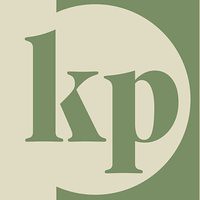 Krause Publications, a leading producer of coin and paper money books, magazines, online properties and events, invites numismatic authors and writers to visit its booth at the World's Fair of Money this August.
Krause Publications, a leading producer of coin and paper money books, magazines, online properties and events, invites numismatic authors and writers to visit its booth at the World's Fair of Money this August.
“We are always on the lookout for great book ideas, magazine articles, or multimedia content,” said KP numismatics publisher Scott Tappa. “I would encourage anyone with an idea they would like to publish to stop by our booth and share it with us.”
At the American Numismatic Association event in Boston, KP will be situated in booths 1629 and 1631. Authors looking to speak with a KP representative are encouraged to visit the booths and ask for:
-Debbie Bradley, editorial director
-Dave Harper, editor, Numismatic News
-Bob Van Ryzin, editor, Coins and Bank Note Reporter
-Scott Tappa, publisher
The KP numismatics booth will be open during general public bourse hours from August 10-14. For more information about KP's line of products visit www.shopnumismaster.com. For more information about the World's Fair of Money visit www.worldsfairofmoney.com.
About Krause Publications
Krause Publications, based in Iola, Wis., is the world's largest publisher of leisure-time periodicals and books on collectibles, sewing and quilting, hunting, and construction. Chet Krause, a long-time collector of coins, published the first issue of Numismatic News on Oct. 13, 1952, with nearly 1,000 readers. Today, Krause Publications, owned by F+W Media, offers more than 40 periodicals, 10 hobby shows, 750 reference and how-to books, and web properties such as NumisMaster.com, the online coin price database.
AUTHOR FRED REED'S WEB SITE ANNOUNCED
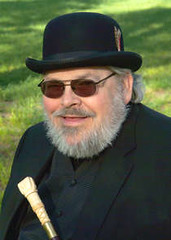 Numismatic author, editor and book packager Fred Reed has a new website.
The site is fredwritesright.com and was launched at noon on June 23, 2010.
Fred has been using the "writesright" trademarked slogan for
his free lance business on and off since 1986.
Numismatic author, editor and book packager Fred Reed has a new website.
The site is fredwritesright.com and was launched at noon on June 23, 2010.
Fred has been using the "writesright" trademarked slogan for
his free lance business on and off since 1986.
He recently was accepted in the prestigious The Author's Guild in June. As readers may know, The Authors Guild is a trade association with membership including big time popular authors like Scott Turow and Judy Blume, feminist icon Susan Brownmiller and celebrity authors such as former Hollywood bombshell Carol Baker.
The Author's Guild is the group that sued and won against Google's indiscriminant ripping off of intellectual property. So they have clout. Fred had the Guild build the website for him.
Fred invites E-Sylum readers to check out the new website. Visitors to the website can order books for your summer reading. They can also visit Fred's Abraham Lincoln Book Shop book signing festivities and interview in Chicago in 2009, or the ANA Numismatic Theater talk he gave on his Lincoln book at the 2010 ANA National Money Show in Fort Worth.
To visit the web site, see: fredwritesright.com
THE BOOK BAZARRE
MORE ON ALAIN DEBELDER'S BELGISCH NOODGELD BOOK
Joe Boling writes:
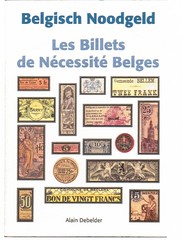 The book on Belgian notgeld that Howard Daniel is looking for is now at the American Numismatic Association. Every year or two, as the awards committee of the International Bank Note Society (IBNS) finishes evaluating books submitted for the IBNS book of the year award, these books are transferred to the ANA library, which is the depository for the IBNS library.
The book on Belgian notgeld that Howard Daniel is looking for is now at the American Numismatic Association. Every year or two, as the awards committee of the International Bank Note Society (IBNS) finishes evaluating books submitted for the IBNS book of the year award, these books are transferred to the ANA library, which is the depository for the IBNS library.
The Belgian book was in the batch of books transferred this year, which arrived at ANA a couple of weeks ago. As soon as they have accessioned it, it should be available for borrowing (unless they place it in the rare book room - perhaps advisable, if it is of such limited availability).
Rich Hartzog writes:
I have located a supply of this book, for the normal retail price of 37.5 euros, plus $4/postage to the USA ($50 plus $4 in US dollars). As I need to order a quantity to get a favorable price, persons interested in a copy should write me immediately at hartzog@exonumia.com. I will then order and ship as promptly as possible.
While I haven't updated my book list lately, I do attempt to stock most exonumia books, at www.exonumia.com/books.htm .
Rich Hartzog
POB 4143
Rockford IL 61110
www.exonumia.com
To read the earlier E-Sylum article, see: QUERY: ALAIN DEBELDER'S BELGISCH NOODGELD SOUGHT (www.coinbooks.org/esylum_v13n29a07.html)
QUERY: COIN BOOKS WITH AN ENCASED COIN OR MEDAL
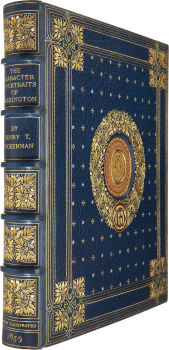 That Washingtonia book with the Jacob Perkins gold oval funeral medal encased in the front cover is an eye-opener. Fortunately, I'll be there to examine it and watch it sell in the Heritage ANA Platinum Night session.
That Washingtonia book with the Jacob Perkins gold oval funeral medal encased in the front cover is an eye-opener. Fortunately, I'll be there to examine it and watch it sell in the Heritage ANA Platinum Night session.
But it reminds me of a 19th century colonial currency book Beverly Hills dealer Jerry Cohen (then in partnership with Abner Kreisberg), showed me perhaps 35 years ago at his shop. An Extremely Fine Noe 1 Pine Tree shilling encased in a glass inset in the book's front cover. As made and originally bound. He wanted $5,000-7,000 for the book.
I can't recall the exact price or the book's title other than it was then quite expensive - the coin itself was worth well under $1000 - and it pertained to colonial currency which I never collected. To this day I don't know if the book was unique. But I suspect someone reading this will know and where it's at today.
There are a number of turn of the century numismatic-related books containing, as originally bound, old medals such as an 1880's George Washington ANS bronze medal and a 1909 Roine-engraved Lincoln medal but are there any other old American coin books containing an encased classic American coin or medal in the cover or in the text?
From the Heritage lot description (emphasis by Jim Neiswinter):
Of special interest to numismatists is Appendix III, a list of 49 items of Washingtonia, reprinted from the Boston Transcript edition of February 10, 1859. The list includes fascinating tidbits of information, such as an early account identifying Martha Washington as the model for the 1792 half disme, pedigree information attributing certain pieces to the collections of contemporary numismatists like Jeremiah Colburn and Reverend Finotti, and general observations on Washingtonia in 1859. The item is signed A.S. (possibly Augustus B. Sage).
Jim Neiswinter writes:
A.S. was Augustine Shurtleff. (He signed the Boston Evening Transcript article on large cents on 3/1/1859 also.)
Joel Orosz agrees:
The article on Washington pieces that comprises appendix 3 of the lovely Washington book that Heritage is selling at the ANA was written by A.S. alright, but not by Augustus Sage, as was speculated. The author was Dr. Augustine Shurtleff of Brookline Massachusetts (1826-1901). The piece was later reprinted on the inside covers of an 1860 Bangs catalogue. Part of Shurtleff's collection was sold by Woodward in 1863, and much of it was given by bequest to the Museum of Fine Arts, in Boston upon Shurtleff's death.
To read the earlier E-Sylum article, see: NUMISMATIC LITERATURE IN HERITAGE ANA AUCTION (www.coinbooks.org/esylum_v13n29a03.html)
MORE ON HOBBIES MAGAZINE
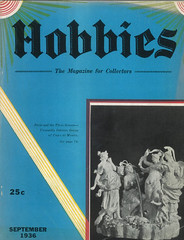
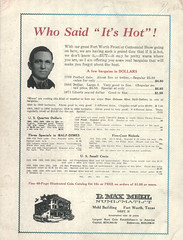
"Hobbies, The Magazine for Collectors" was a tremendous publication that covered any and all collectible items. From coins to stamps, from penny banks to firearms, from canes to railroadiana, from lithographs to Indian relics, from miniatures to antique furniture, from records to wood cut prints of the 19th century, from autographs to presidential items, from old dolls to old books, from postcards to exquisite glass, from rocks and minerals to early American pioneer life, it was well written about in this fine monthly publication.
For numismatists, this is the only source for the 1931 A.N.A. auction in Cincinnati. The August issue discusses the upcoming A.N.A. convention, while the November 1931 issue has the listing and prices for the A.N.A. sale. This is the only source as there was no separate catalogue ever printed.
B. Max Mehl had a full page advertisement on the rear cover, while Thomas Elder had a full page ad inside the front cover (at least in the late 1930's). Elder also wrote a column about numismatics. In the August 1936 issue, in his column titled, "Recollections of an Old Collector" Elder discusses the recent death of Col. E.H.R. Green and the collection that he had assembled. He also relates his 1930 journey to Rutherfordton, North Carolina, where the Bechtler coinage was struck and continuing on to Dahlonega, Georgia where the Mint was in existence from 1838 to 1861. He also took pictures of gold mine shafts.
Coin dealers Ira Reed, Norman Shultz, Rollo Gilmore, A. French, L.W. Hoffecker, D.C. Wismer, Walter P. Nichols, Charles Fisher, and M.H. Bolender were advertisers as well. Other unknown numismatic advertisers were "in the coin business" because of the Commemorative Half Dollar craze that was sweeping the country.
There is interesting source material for researchers, as seen in the November 1931 article about the father of Mrs. Erna Brand Zeddies collection which was part of the Virgil Brand collection. Robert Zeddies (husband of Erna) was the sales manager of the Kroger Grocery and Baking Co. Horace Brand (Erna's father) even wrote an article about cents circulating in America since 1793.
The September 1936 issue had an article about President Franklin D. Roosevelt and his collecting of items having to do with the U.S. Navy, American philatelic (stamps) material, and N. Currier and Currier & Ives prints of the Hudson River. It was mentioned in the interview that F.D.R,. had visited the Merwin-Clayton auction house in New York during the first few years of the 20th century. Also noted was Alice Roosevelt, oldest daughter of President Theodore Roosevelt, who had a collection of old manuscripts. Secretary of the Interior in Roosevelt's administration, Harold Ickes, was also a dedicated stamp collector.
Numismatic director for Hobbies, Frank C. Ross, who lived in Kansas City, is mostly remembered for creating the "Orphan Annie" 1844 dime. He placed ads looking for this date as early as 1931 and had very few responses, thus recognizing the scarcity of that particular coin.
This timeframe was just before the separation of the collectibles markets, and offers a lot of interesting reading and background information for the collector. It's definitely an overlooked resource for the numismatist.
To read the earlier E-Sylum article, see: THE HOBBIES MAGAZINE BUILDING IN CHICAGO (www.coinbooks.org/esylum_v13n29a20.html)
MORE ON THE LIBRARY OF COINS AND TREASURY OF COINS ALBUMS
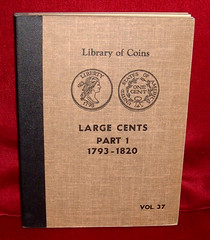 I recall that circa 1960 the new Library of Coins albums were a sensation. We had a display rack of them, and they sold quickly. By that time the Raymond (National) albums were available but hard to find and, as I recall, promotion for them had stopped. We found that the Type Set album in particular inspired buyers to get busy building a type set.
I recall that circa 1960 the new Library of Coins albums were a sensation. We had a display rack of them, and they sold quickly. By that time the Raymond (National) albums were available but hard to find and, as I recall, promotion for them had stopped. We found that the Type Set album in particular inspired buyers to get busy building a type set.
These were among the new products that ignited the great coin market of 1960-1964, the prime catalysts being the inauguration of Coin World and the pandemonium created by the “very rare” 1960 Small Date Lincoln cent.
In this single year numismatics evolved from a hobby to a big business. Coin shops by the thousands opened (think: sports cards shops in the 1990s), and at one point the circulation of Coin World crossed 150,000. The market leader was the bank-wrapped $2 roll of 1950-D nickels which at one point sold for over $1,200.
Interesting to reflect upon today!
Dave Lange adds:
To follow up on James Higby's observations about the Library of Coins albums, the titles for pre-1840 coinage were in print for several years but were not big sellers. Even 45 years ago there were relatively few people assembling date and variety sets of early federal coins; most were too busy hoarding BU rolls and proof sets. That's why these titles are hard to find today. The only one to be produced in a second edition was Volume 38, which was for Large Cents 1821-57. Evidently that period of cents was popular enough for the album to have sold out in the first edition.
As for the incomplete roster of varieties, this represented what was included in the Red Book circa 1960-61, when these albums were being designed. Though a few varieties may have been added to or deleted from the Red Book during the course of the 1960s, the albums were never updated.
To read the earlier E-Sylum article, see: MORE ON THE LIBRARY OF COINS AND TREASURY OF COINS ALBUMS (www.coinbooks.org/esylum_v13n29a15.html)
ROBERT READY AND SONS, ELECTROTYPISTS
Dick Johnson writes:
The British Museum hired a sealmaker, Robert Cooper Ready (1811-1901) in 1859 to make copies of coins, medals, seals and gems in their collections. He started replicating these by casting but quickly turned to electroforming -- then a new technology -- to make the objects because of the sharper detail he could obtain by this process. Forrer called him a pioneer in reproducing coins and medals by electrotype.
In his lifetime Ready made over 22,000 of these objects. He trained his sons, Augustus P. Ready and Charles Ready, to carry on after him. They continued these replications for another decade into the 20th century.
Dozens of authors have written on electrotypes in the numismatic field --both those made in museums and made privately -- in addition to the technical electroforming literature in the metalcasting field. I have attached a 3-page list of these to be forward to Charley Marsteller for his research.
Jim Duncan of New Zealand provided Charley with a copy of an article he'd written on the Readys in 1991 for MINTMARK, a publication of the Numismatic Society of Auckland. In it he quotes the entry on Ready in Forrer's Encyclopedia:
“READY, ROBERT COOPER. (Brit) modeller, and sigillarist and electrotypist, born at Norwich, 28 June 1811; died at Camden Town, London, 15 May 1901.
From his early youth he had a penchant for medieval seals and in the ‘40s he found himself relying entirely on the work in connection with these and kindred objects of glyptic art. He worked in Norwich and Cambridge, and finally combined his private practice with an appointment which he took up at the British Museum in 1859 and held until within 4 weeks of his decease. He was a pioneer in the work of reproducing coins and medals by the electrotype process, and had among his clientele several of the Royal Houses of Europe.
A medallic portrait of him was modelled in 1879 by G A Carter, and the gem engraver Luigi Isler cut his intaglio portrait.”
Philip Mernick writes:
Harry Manville's Encyclopedia of British Numismatics, Volume IV (2009) has quite a lot of information on Robert Cooper Ready and sons Charles Joseph, Augustus Papworth, and William Talbot Ready.
Charley adds:
I have just located a book by B.V. Head "A Guide to the Select Greek and Roman Coins Exhibited in Electrotype" published by the Department of Coins and Medals sometime before 1923 (exact date not listed).
It says in the introduction: "Mr.Ready, Electrotypist, British Museum, supplies single electotypes (obverse and reverse) of any of the coins described in this Guide [790 coins], at 2s. 6d. each [I was born too late!]. Complete sets for museums, schools, &c, classified and labeled, in cases lined with velvet, as in the British Museum, can also be obtained from him."
No doubt Mr.Ready would deliver them personally to you, also!
To read the earlier E-Sylum article, see: QUERY: ROBERT READY AND SONS, ELECTROTYPISTS (www.coinbooks.org/esylum_v13n29a13.html)
VIETNAMESE BANKNOTE OVERSTAMP TRANSLATION: RUPIA?
Last week Howard Daniel wrote:
The note I just re-found has an overstamp on it too but the word is Mupia or Nupia or something else. The word could mean exchanged, cancelled or annulled. The note could have been exchanged in a Vietnamese Embassy somewhere in Europe and they applied an overstamp on it in the local language.
Besides showing the actual note with the overstamp in its upper right corner, I am also showing what I believe to be what I can see of the overstamp. My question is; can someone fluent in the language of the overstamp translate it for me? Thank you in advance for anyone translates it.
P. K. Saha writes:
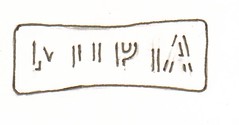 The overprint on Vietnam note is Rupia since at one point, there was a proposal to rename the currency as Rupia.
The overprint on Vietnam note is Rupia since at one point, there was a proposal to rename the currency as Rupia.
To read the earlier E-Sylum article, see: QUERY: VIETNAMESE BANKNOTE OVERSTAMP TRANSLATION SOUGHT (www.coinbooks.org/esylum_v13n29a12.html)
THE BOOK BAZARRE
COPYRIGHTS AND REPRINT PERMISSION: WHERE AND FOR HOW LONG?
I believe I have a few questions more in keeping with the purpose of this email newsletter!
Years ago, I started thinking about a book on Alaska numismatics, gathering articles that I thought would show the history of the territory through its monetary instruments.
I have used some of these articles in my newsletter (with permission).
My question is this: If I have permission to reprint something, does that permission expire? I would assume that if I have permission to use it in the newsletter, I would have to get additional permission to include it in a book.
Now, if a magazine had an article I would like to include, but is no longer in business, how do I find the copyright holder?
Thanks for your help. I am sure the answers will generate more questions.
Now, if the newsletter were to be compiled into a book format, I don't think additional permission would be needed - it's still the newsletter, just presented in another form. But publishing the content in a book totally separate from the newsletter is problematic.
As for finding copyright holders, this was discussed in earlier issues, such as Ben Keele's response in the March 21, 2010 issue. See: MORE ON SHIRJIEH PUBLISHERS AND COPYRIGHTS . (www.coinbooks.org/esylum_v13n12a12.html) -Editor
DICK JOHNSON: I'M NOT UNFRIENDLY, JUST SLOW TO ADOPT NEW FADS
Facebook has exploded in recent weeks. Last week alone I received eleven offers. The overture states "(name) wants to be friends on Facebook."
These have come from people I already consider friends (without electronic documentation or authentication). Included were coin dealers, medallic sculptors, a U.S. mint engraver, assorted numismatists, and even your E-Sylum editor, Wayne Homren. I haven't responded to any of these, and until I had to write this message I really didn't know why.
My first thought was "I'm too busy, I'd rather devote my time to my numerous book projects and my new association with Medallic Art Company in addition to my commercial venture with partner Mark Schlepphorst in Signature Art Medals." But, really, I argued with myself, shouldn't I take time to be friendly with someone who is extending a friendly gesture?
Then I realized my real reason: I am slow to adopt new fads. I saw in my mind Facebook as a kind of diary, a public diary of an individual's activities. At my age I want to devote every modicum of time to my chosen numismatic projects. I probably won't live long enough as it is to write all the numismatic books I would like. Do I even want to read a friend's Facebook entries? Could Facebook be a Fadbook?
I DO want to be friends with the multitude of people I have met in the numismatic field. Thus I so look forward to the Boston ANA Convention in two weeks. I will be attending for the full week. It will be something like my 30th ANA convention but I haven't attended the last few years.
This year I want to meet a lot of old friends and make new ones. So I am pleading, stop by my bourse table # 1 - 2 - 3 - 0 (center isle, across from the escalators). It is a combination of Signature Art Medals -- Medallic Art Company and it is more educational exhibit than commercial venture. We will have four medals and a lithograph for sale, but I want to meet and chat with you. Look over our medallic items on exhibit. Pick up and handle dies and hubs. Please ask questions.
Meanwhile I need to be convinced to respond favorably to all those Facebook entrees.
Like many others, I'm finding I need to become much more selective on Facebook. Are you a relative? A neighbor (past or present)? Have you visited my home? Have I visited yours? Have we even broken bread together? I find I've ended up with way too many "friends" on Facebook that I've never even met in person.
The E-Sylum of course, is another story. If I were starting The E-Sylum, today I just might choose Facebook as the platform to build it on (separately from my personal Facebook account). Back in 1996 Facebook founder Mark Zuckerberg was twelve years old and email was the only truly viable platform for pushing content to people worldwide.
If I were to survey E-Sylum readers today, I'm sure there are many with Facebook accounts, but many more without (or like me, with a fairly dormant one). We do have an E-Sylum RSS feed. If there's a way to hook that into Facebook maybe we could start dipping our toes into the Facebook water. If anyone is familiar with building Facebook interfaces, let me know. -Editor
RESPONSE TO OPINION ON COIN DESIGN BY COMMITTEE
Regarding Tim Shuck's CoinLink opinion piece on designing U.S. coins, Donald Scarinci sent the following reply to CoinLink, copying The E-Sylum:
"We agree that design by committee is not the optimal way to produce attractive coins and medals. You seem to suggest that there is another way but after you criticize the CCAC for trying you don't suggest anything. I would love to take your suggestions and the suggestions of your readers back to the CCAC coin design subcommittee at our meeting on Monday.
There are few people more critical of the US Mint than me, but criticism alone does not change things. We need to offer suggestions and propose changes that can be made to the process. Now is the time to hear it. So please speak up. No one has a monopoly on good ideas.
To read the earlier E-Sylum article, see: OPINION: TIM SHUCK ON COIN DESIGN BY COMMITTEE (www.coinbooks.org/esylum_v13n29a17.html)
GET RID OF COINS ALTOGETHER?
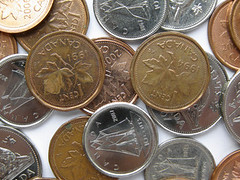 The headline caught my eye. "Get Rid of Coins Altogether." I could not click on the article fast enough. I expected some editorial writer wanted to abolish all coins in Canada (for an all plastic economy I thought?).
The headline caught my eye. "Get Rid of Coins Altogether." I could not click on the article fast enough. I expected some editorial writer wanted to abolish all coins in Canada (for an all plastic economy I thought?).
But the article in the Toronto Star presented an excellent viewpoint on eliminating the penny alone -- not all coins. It was a sloppy headline writer who caused the confusion.
So Canada keeps its coins. This opinion writer joined the growing movement in Canada to stop minting cents. The U.S. should consider the same move.
Here's the article that soothed my jaded nerves:
Get rid of coins altogether
(www.thestar.com/opinion/letters/article/837680
--get-rid-of-coins-altogether)
NOTES FROM E-SYLUM READERS: JULY 25, 2010
On Effects of the Impending 1099 Law
Dick Johnson writes:
I predict: Because of the impending tax on gold coin purchases, buyers will try to beat the deadline by buying heavily at ANA Boston convention this August.
Section 9006 of the Patient Protection and Affordable Care Act will amend the Internal Revenue Code to expand the scope of Form 1099. Currently, 1099 forms are used to track and report the miscellaneous income associated with services rendered by independent contractors or self-employed individuals
Starting Jan. 1, 2012, Form 1099s will become a means of reporting to the Internal Revenue Service the purchases of all goods and services by small businesses and self-employed people that exceed $600 during a calendar year. Precious metals such as coins and bullion fall into this category and coin dealers have been among those most rankled by the change.
To read the complete article, see: Gold Coin Sellers Angered by New Tax Law (abcnews.go.com/Business/gold-coin-dealers-decry-tax-law/story?id=11211611)
Finding Homes for Auction Catalogs
Bob Knepper writes:
Many months ago I asked, and you posted, my question of what to do with several hundred European auction catalogs from about 1980 to 2000. I didn't receive any answers and I just got confirmation of my suspicion. I asked George Kolbe and he confirmed that despite their quality and cost to the issuer they aren't worth the cost of inventorying, packaging, and shipping them to him. A few years ago I checked at local coin clubs and they are not interested in non-USA material. I may cut some pictures from some of the catalogs but I'm running out of space so they will be trashed.
Carlson Chambliss Found
Some queries take a while to be answered, but good things come to those who wait. In June 2002 Gar Travis wrote:
"Does anyone know how to contact Carlson R. Chambliss? I understand he has produced a poster of Military Payment Certificates. I am mounting an exhibit on July 1st in the Harriotte B. Smith Library on board Marine Corps Base Camp LeJeune and heard from currency dealer Daryl C. Spekbring of Virginia Beach, Virginia that such a poster exists. I would like to obtain one to use to accompany the exhibit either from Chambliss or another available source.
Now Garth writes:
This has to be one of the longest times between inquiries and replies...eight years!
Carlson R. Chambliss writes:
In checking over references to me on the Internet I noticed that you wanted to contact me about the MPC replica notes that I made a few years ago. I still have plenty of them both as cut singles and in sheets. There are a total of 107 different notes in the full set from Series 461 (first used in 1946) to Series 701 (the last unissued set intended for Vietnam).
There are three different sheets - fractionals, middle size notes (i. e., $1 and small-size $5 notes), and the large-size notes. They are very large in size - 28 x 40 inches. This is because the plates were extremely expensive, and I had to keep the number of plates to a minimum.
My postal address is P. O. Box 804, Kutztown, PA 19530 and my telephone number is 1-610-683-6572. My email address is crchamblis@verizon.net (Note one "s" only.)
Wild Ideas About Coin Values
Regarding the Trinidad man's "rare" coin, Dick Doty of the National Numismatic Collection at the Smithsonian writes:
About thirty years ago, when I was still at the American Numismatic Society, I got a letter from someone in port of Spain calling himself the Kane Detection Agency. Seems he had a 1923 silver dollar that had belonged to President Harding and was actually on his person when he died. Kane said he'd already been offered a million and a half for it, and would we offer more for it? I wrote back, told him that if someone offered me a million and a half for a coin worth seven dollars of so, I, personally, would go for it.
He must've taken the offer, because I never heard from him again.
To read the earlier E-Sylum article, see: ARTICLE: TRINIDAD MAN READY TO PART WITH HIS "RARE" COIN (www.coinbooks.org/esylum_v13n29a21.html)
Protecting and Restoring Leather Bindings
Steve Frank writes:
Many thanks to Michael Sullivan and Kim Ghobrial for the wonderful suggestions, and to Wayne Homren for posting the original question to the group. I've shared these responses with others in my colonial coins groups and believe the answers given will make those who do have leather bound books take notice and act appropriately.
Although I assumed the majority of those who have rare or expensive leather bound editions would know this, I found that some had never given it a thought until now! Thank you once again for helping to save some beautiful numismatic books to be enjoyed by future generations of coin collectors!
To read the earlier E-Sylum article, see: ON RESTORING LEATHER BOOK COVERS (www.coinbooks.org/esylum_v13n29a11.html)
WAYNE'S NUMISMATIC DIARY: JULY 25, 2010
Yesterday my son Tyler and I traveled to the Annandale (Virginia) Coin Show to attend the kids' event I helped organize. Tyler loves animals so much that one of my nicknames for him is "Doctor Dolittle". The guest speaker was Bill Mullen, and I'd heard he would be giving the kids coins with animals on them.
It was a hot, hot day and it was already 80-some degrees when we arrived about 10AM. We signed in with Wayne Herndon's daughter Tiffany, and soon ran into Wayne himself, Bill Eckberg and Roger Burdette. I introduced Tyler to everyone. He was quiet and shy, and I wondered if he was already second-guessing his decision to come. But I needn't have worried - he had a great time.
After helping me set up the room we met Mr. Mullen and I introduced myself. We'd never met in person before - he'd been recommended to me as a speaker by Howard Daniel. We took him to the room where fellow volunteers Mike Hudson and Jon Radel arrived with family members in tow. I excused myself and took Tyler over to the bourse floor for a while.
We found a foreign coin dealer and started looking for animal coins, particularly ones with dogs. We came up empty on the dog part but did find a neat bear on a Kazakhstan piece. We didn't buy it (yet), but Tyler did get a couple tokens, one from Chuck E. Cheese and another from Disneyland, picturing Cinderella's castle.
Back at the kids' event there were over thrity people already present. Shortly after 11am I introduced myself, welcomed everyone, and explained the program. Then I turned it over to Bill.
He did a great off-the-cuff presentation starting with a description of the world before there was any money. He told a great story of how two warring tribes bartered with each other: a certain amount of fish and seafood from one oceanside tribe in exchange for a certain amount of fruits from the mountain-based tribe. He discussed the pros and cons of the barter system and gradually turned to a discussion of primitive forms of money.
He illustrated his talk by handing around the room actual items such as Chinese knife money, tea money, Swedish plate money, etc. Not a piece was missing or out of place by the end of the talk. The parents later told me they were amazed that their kids paid rapt attention for 45 minutes.
QUICK QUIZ: why do Chinese cash coins have SQUARE holes in them? The talk had something for everyone, even experienced numismatists like me.
At the end he invited the kids to line up and each was able to take a free coin from one of three bags he'd brought. There was a great round of applause for him. Thanks, Bill! (And Howard, too!)
Next, I ran an auction of 17 lots of donated material ranging from an Indian cent to a One Hundred Billion Dollar Zimbabwe banknote. The kids had a great time. Tyler bagged a U.S. Mint set. He helped us straighten up the room afterwards but couldn't wait to get back to the bourse.
I had to stop at Wayne Herndon's table but told Tyler he could head back to the other dealer's table. I was about to head over there when I saw him running through the aisles toward me. He'd made a deal on the bear coin and one other (and needed Dad's five bucks). So we went back and bought the coins.
I made a bet with him on the way out. Who would have the closest guess for the outside temperature? Tyler won - when I turned on the car, the temperature reading was 93 degrees. As we drove away he asked me to hand him his coins so he could look at them.
We stopped at a McDonald's in Tyson's Corner for lunch. Getting back in the car, we had to stop and look again at all of his coins before leaving the parking lot. I showed him how he could view more detail through my magnifying glass. As we drove home the temperature was 105 degrees, the hottest day of the year.
When we got home he had to show the whole family his purchases. Mom wasn't impressed with the Chuck E. Cheese and Disney tokens. But Tyler was happy. He even dumped toys out of a plastic bin from his closet so he could house his coins in them. Mom didn't much care for that, either.
I dug out a bag full of coins I'd set aside during my trips to London. I told him he could take three of them for his collection, and I think he made some nice picks, including a 50-pence commemorative. I made his sister Hannah the same bargain. The little golddigger went for the one and two-pound coins.
Back when we lived in Pittsburgh I'd taken both Tyler and his older brother Christopher to the Coins4Kids meetings at the PAN Shows. Once we moved to Virginia a few years ago they showed less interest in coins. So it was nice to see it rekindled in Tyler. Only time will tell how long it lasts, but Dad was sure happy for a day, despite the withering heat.
SHIELD NICKEL RUBBING IN METHODIST SUNDAY SCHOOL BOOKLET
Inspired by the earlier item on the fifty cent Trenton, TN note with a half dollar image, Harold Levi writes:
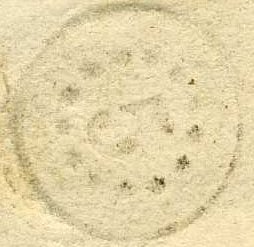 My father was a Methodist circuit rider in 1954/1955. He was stationed in the Great Smoky Mountains of East Tennessee outside of Cosby. At that time, Cosby was the moonshine capital of East Tennessee and has been said to have been the inspiration for the movie Thunder Road. I have seen many whiskey tankers (hotrod Fords with tanks built into the trunk and back seat and rear springs from a truck) and some model A's moving stills strapped to the roof.
My father was a Methodist circuit rider in 1954/1955. He was stationed in the Great Smoky Mountains of East Tennessee outside of Cosby. At that time, Cosby was the moonshine capital of East Tennessee and has been said to have been the inspiration for the movie Thunder Road. I have seen many whiskey tankers (hotrod Fords with tanks built into the trunk and back seat and rear springs from a truck) and some model A's moving stills strapped to the roof.
While cleaning the church for Sunday meeting, I found a stack of old Sunday School books. I thumbed through several of them and found a rubbing of a Shield Nickel in one. Since no member of the church could remember when the books were last used, I was given permission to keep the books.
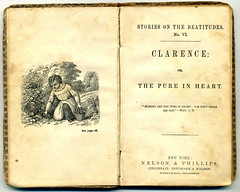 There are about twenty of them. The books are 3 3/8ths inches wide by 5 3/8ths inches high by 1/4 inch thick and contain about 60 pages. Each book contains a Bible lesson. Also, the book with the rubbing contained a ticket to a religious meeting in, I think, Knoxville, TN. The ticket is dated December 8, 1901.
There are about twenty of them. The books are 3 3/8ths inches wide by 5 3/8ths inches high by 1/4 inch thick and contain about 60 pages. Each book contains a Bible lesson. Also, the book with the rubbing contained a ticket to a religious meeting in, I think, Knoxville, TN. The ticket is dated December 8, 1901.
This book was entered into the Library of Congress in 1848. I do not know when this particular book was printed or placed into service. It is well used but the binding is still intact. The covers are a thick paper board of some kind with a paper covering.
To read the previous E-Sylum article, see: AN ATTRIBUTABLE BUST HALF IMAGE ON AN 1837 TENNESSEE NOTE (www.coinbooks.org/esylum_v13n28a15.html)
THE BOOK BAZARRE
U.S. TREASURY SEEKS COMMENT ON PAPER MONEY CHANGES FOR THE BLIND
The Federal Register has published for public comment changes to United States Federal Reserve Notes — U.S. paper currency — to make them accessible to the blind and the visually impaired, knowing that the alterations will financially affect some ATM, kiosk and self-checkout owners and operators.
"The purpose of this Federal Register notice is to inform the public of the features the Bureau of Engraving and Printing intends to propose to the Secretary of the Treasury to accommodate people who are blind and visually impaired and to solicit public comment on the proposed accommodation," the Federal Register wrote in the proposal titled, "Meaningful Access To United States Currency for Blind and Visually Impaired Persons."
The Bureau of Engraving and Printing, which prints Federal Reserve Notes, is proposing as part of the design a tactile feature that will be unique to every banknote, enabling users to identify each denomination through touch. The government agency also will continue with its current practice of adding high-contrast numerals and different and distinct color schemes to each denomination to assist the visually impaired.
In addition, the government agency proposes to loan and distribute currency readers to the blind and visually impaired. The reader would ameliorate difficulties stemming from the transition during the co-circulation of notes with and without a tactile feature and large, high-contrast numerals. "The transition will continue for many years, following introduction of tactile-enhanced note," the Bureau of Engraving and Printing said.
The bureau supports tactile features on currency, although some ATM industry officials have complained they may cause ATMs to jam or malfunction. The executives also claim tactile bumps will reduce the amount of currency ATM operators could deposit in the machines' cassettes; therefore, they would have to keep a higher inventory of funds to ensure that a sufficient amount of cash is available at all times.
Despite ATM industry opposition to tactile banknotes, the bureau will recommend them to the Treasury Department because the blind and visually impaired find them accurate and easy to use. Federal officials, however, are concerned the tactile features quickly will wear out. But they plan to develop a much more durable raised figure that can be incorporated into the current manufacturing process.
The Treasury Department will accept until Aug. 18 comments on the proposed currency changes.
To read the complete article, see: Treasury considers changes to U.S. banknotes (www.selfserviceworld.com/article.php?id=24847)
HONG KONG TO ISSUE NEW BANKNOTES WITH BRAILLE
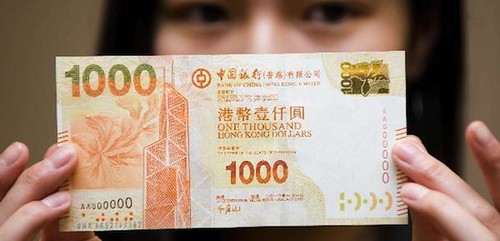
Hong Kong is to follow China' s lead and begin to produce banknotes with Braille and embossed lines for the visually impaired, the Hong Kong Monetary Authority announced on Tuesday.
China has issued its yuan banknotes in Braille for several years.
The new Hong Kong notes will be phased in over the next two years and will feature Braille at the bottom left corner of each note, together with embossed lines that correspond with each notes value.
To read the complete article, see:
Hong Kong to Issue New Banknotes with Braille
(www.china-briefing.com/news/2010/07/21/hong-kong
-to-issue-new-banknotes-with-braille.html)
BANKNOTE PRINTER DE LA RUE HALTS PRODUCTION OVER PAPER QUALITY
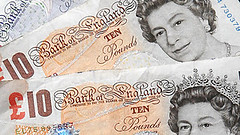 The quality of the world's banknotes has been questioned after the leading printer suspended production over paper issues.
The quality of the world's banknotes has been questioned after the leading printer suspended production over paper issues.
De La Rue, which produces banknotes for 150 countries from its Hampshire base, will not confirm whether inferior notes have ended up in circulation.
The company has been forced to suspend the relevant production and shipment departments to allow for an investigation.
The probe was issued after delivery teams noted paper issued to central banks and other printers was sub-standard.
De La Rue discovered irregularities in the quality and production of the notes at its 600-worker plant in Overton, Hampshire.
"It is apparent that some paper production has failed to meet certain quality specifications," a spokesperson said.
"As a consequence, the production and shipment of this specification paper has been suspended while the circumstances are fully investigated."
How long the problem went undetected remains unknown.
The uncertainty has seen De La Rue's share price fall to a three-year low after the company warned its paper revenues are likely to be "materially lower" than expectations.
Analysts are fearful the problems will damage the company's reputation with central banks.
To read the complete article, see:
Printing Error May Undermine Banknotes
(news.sky.com/skynews/Home/Business/Printing-Error-Undermines
-De-La-Rues-Banknotes-Halting-Production-At-Printers-Hampshire-
Plant/Article/201007315668682)
PENNSYLVANIA ARCHEOLOGISTS FIND VIRGINIA HALFPENNY
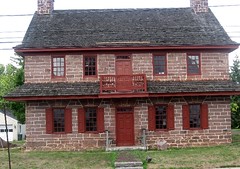 Archaeologist Lou Farrell didn't exactly strike gold when he and his crew dug up an old coin at the Henry Muhlenberg House this summer.
Archaeologist Lou Farrell didn't exactly strike gold when he and his crew dug up an old coin at the Henry Muhlenberg House this summer.
But if the elation in his voice is any indication, to him the 1773 Virginia copper halfpenny is even more valuable.
“This was heavily used; it's not just messed up from being in the ground,” Farrell said, handing over the coin with the murky likeness of King George III, eroded by nearly 250 years of earthen confinement.
Tons of these coins were minted for the budding southern state of Virginia at the Tower Mint in London, but colonists hoarded them instead of spending them, Farrell explained.
“The whole expedition was done by amateurs. I was here, along with a Temple University graduate who has a degree in anthropology. But that was it as far as people with higher levels of training.
“The thing is, you don't need a master's degree to screen dirt,” he added. “There are a lot of things kids can do on site if they're trained properly. A lot of times, if you're an amateur working on a dig, you come out for a couple of hours. Nobody uses amateurs the way I do, because what we're doing here is giving them some pretty high level skills — teaching the kids how to do the documentation and understand the artifacts. They're making a real contribution to the science.”
By Farrell's expert estimation, this was where the home's traditional Pennsylvania Dutch summer kitchen once stood when the house was built in 1776.
“We knew we wanted to dig because I knew there was stuff here and I looked at enough 18th-century farms to know that this was where the summer kitchen was supposed to be,” he said.
The kitchen burned down in 1779.
To read the complete article, see: Harvesting history: Muhlenberg House Archaeological Excavation Project (www.timesherald.com/articles/2010/07/24/news/doc4c4bbe3c92a52553678593.txt)
For more information on the Henry Muhlenberg House, see: The Henry Muhlenberg House (www.trappehistoricalsociety.org/muhlenberg.html)
ARCHEOLOGISTS UNEARTH FIRST ANTONIUS PIUS COIN FOUND IN ISRAEL
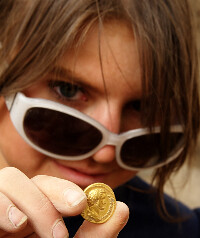 A 2,000-year-old gold coin discovered by a West Virginia University student at an archaeological site in the upper Galilee has proven to be the find of the season.
A 2,000-year-old gold coin discovered by a West Virginia University student at an archaeological site in the upper Galilee has proven to be the find of the season.
It is the first Antonius Pius coin ever found in Israel and was discovered by Alexis Whitley and her friend, on one of the hottest days of the summer. The two were clearing away dirt and rocks at the Bethsaida site when suddenly, Alex spotted the sparkle of a coin as it slipped down.
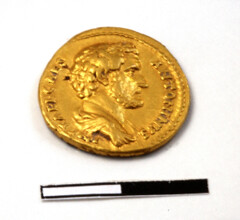 The coin, which Arav described as a discovery of Biblical dimensions, weighs 7 grams of 24-karat gold – 97.6 percent gold, to be exact. It depicts the portrait of Antonius Pius, a Roman emperor who ruled from 138-161 CE.
The coin, which Arav described as a discovery of Biblical dimensions, weighs 7 grams of 24-karat gold – 97.6 percent gold, to be exact. It depicts the portrait of Antonius Pius, a Roman emperor who ruled from 138-161 CE.
Arav, a professor at the University of Nebraska, said the coin was issued to celebrate Pius' designation of consul for a second time, which according to historical records took place in the summer of 138 CE. He noted that Pius' ascension to consul should have been indicated with an announcement on the flip side of the coin – but instead, the coin shows a portrait of the goddess Pietas – which the chief archaeologist said may have been a rare and valuable misprint. “Somebody in the Roman Imperial mint goofed. It is like having a rare and mistaken silver dollar,” Arav explained.
To read the complete article, see: 2,000-Year-Old Gold Coin a Testament to Galilee Ancient History (www.israelnationalnews.com/News/News.aspx/138649)
BLOGGER BARMAN PROFILED BY THE SATURDAY EVENING POST

 Very few publications can trace its roots back to colonial times. One of those publications is The Saturday Evening Post.
Very few publications can trace its roots back to colonial times. One of those publications is The Saturday Evening Post.
Through this long history, The Saturday Evening Post continues to publish a variety of stories including those of general interest. One of The Post's regular columns is “Collectible News & Notes.” As part of the column, The Post features a collector and their passion for what they collect. In the July/August 2010 issue (Vol. 283, No. 4), your blog host is the featured collector.
I was contacted via email by the writer of the article. After we exchanged a few notes, he called me one afternoon. I happened to have been driving to a local grocery store when he called. I spent most of our one-and-a-half hour conversation while sitting in the parking lot in front of the grocery store. It was a pleasant conversation and I am sure I gave him more information than he asked for. He distilled the conversation into a nice article that appears on one page—even though there is a minor mistake (in the caption under the picture, it should say that I am still looking for a 1909-S VDB Lincoln Cent in change).
Two weeks after our discussion, a local freelance photographer visited my home to photograph me and my coins. The photographer was a pleasant woman who also took pictures of my dogs. My wife liked the pictures that appear in the magazine.
To read the complete blog post, see: The Saturday Evening Post (coinsblog.blogspot.com/2010/07/saturday-evening-post.html)
DARING SWEDISH CHOPPER HEIST NETS $5 MILLION
A Swedish court said Monday 10 men have been charged in connection with a dramatic helicopter raid on a cash storage depot south of Stockholm last September.
Only a small fraction of the amount, about 100,000 kronor (10,400, 13,600 dollars), has been recovered.
Three masked, armed men were dropped onto the roof of the banknote storage facility by a helicopter in the early hours of last September 23.
The men then smashed a window and blasted their way through the building using explosives before exiting the building several minutes later with sacks of cash.
The robbers carried out the raid in front of police and 21 workers present in the centre.
The police were hindered because a bag marked with the word "bomb" had been previously placed at the police helicopter base.
The thieves' helicopter, which was stolen shortly before the raid, was recovered undamaged several hours later north of Stockholm.
To read the complete article, see:
Ten men charged in spectacular chopper robbery
(www.swedishwire.com/component/content/article/
3:general/5447:ten-men-charged-in-spectacular-chopper-robbery)
CIGARETTE VENDING MACHINES CONVERTED TO SELL BOOKS
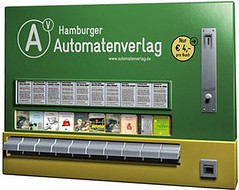 German publishing company Hamburger Automatenverlag (Hamburg Automatic Publishing) has adapted old cigarette vending machines to sell books instead of cigarettes at various locations in Hamburg.
German publishing company Hamburger Automatenverlag (Hamburg Automatic Publishing) has adapted old cigarette vending machines to sell books instead of cigarettes at various locations in Hamburg.
The repurposed machines carry a series of condensed novels, photo books, graphic novels and collections of poetry by local authors -- all designed to be exactly the same size as a packet of cigarettes. The idea is to get people into the habit of reading as opposed to smoking.
Germany's increasingly strict smoking regulations mean that coin-operated cigarette vending machines are being replaced by modern versions which can scan identity cards for age verification purposes. This means that the old mechanical versions will become obsolete as of November 2010.
Instead of scrapping the robust machines, which are famed for their craftsmanship, a few small adjustments have been made to complete the vice-to-virtue transformation. To operate the machines you select your desired book, insert coins to the value of €4 (£3.30), tug on a spring-loaded lever and the requested book is dispensed into a retractable metal drawer.
To read the complete article, see: Cigarette vending machines converted to sell books (www.wired.co.uk/news/archive/2010-07/22/cigarette-machines-sell-books)
FEATURED WEB PAGE: HARRY BASS NUMISMATIC LIBRARY CATALOGS
This week's Featured Web Page is from the bibliography section of the Numismatic Bibliomania Society web site. Tom Wetter has been volunteering a great deal of time and images to flesh out the United States portion. This page is a great example of his work - it describes George Kolbe's auction catalogs for the Harry Bass numismatic library, featuring text from Len Augsberger's 100 Greatest Items of American Numismatic Literature.
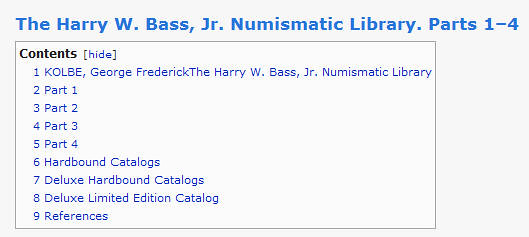
A two thousand lot celebration of American numismatic literature, this writer's task might have been considerably simplified given a few days inside the Bass library - but more likely we would have been distracted to the point of paralysis. Where to begin? Bid books of all flavors abound, while plated versions of the important early sales seem prolific as kudzu. Impossible items like Thian's Register Of The Confederate Debt, or the E. H. R. Green eagle and half eagle photographic plates seem to appear every few pages.
Other delicacies include Bushnell's copy of the Roper sale, Hart's treatise on colonial paper money with historical chart, and The Numismatist from the first President of the ANA. Beyond individual rarities, the capable executive Bass was more than happy to leverage the efforts of others, in particular Melvin and George Fuld, who contributed to the Bass collection Woodward, Low, Haseltine, Frossard and Elder sets, among other items. A decade later, many of the prices realized in the Bass sale seem quite attractive – yet another reminder that today's record price is often tomorrow's bargain.
wiki.coinbooks.org/index.php/The_Harry_W._Bass%2
C_Jr._Numismatic_Library._Parts_1%E2%80%934
